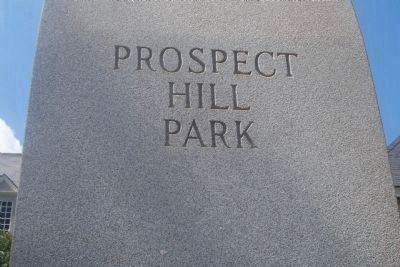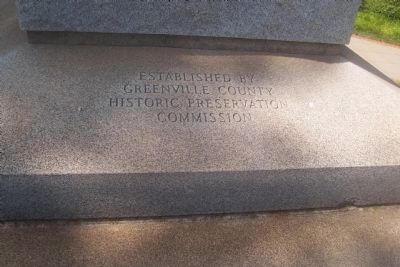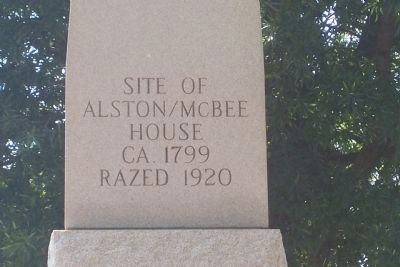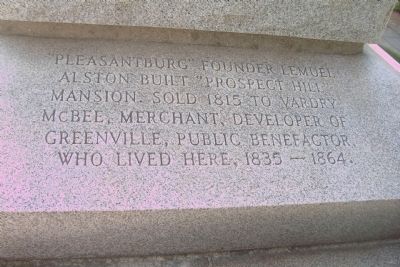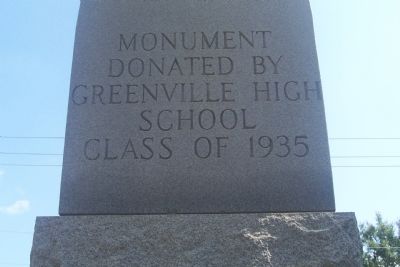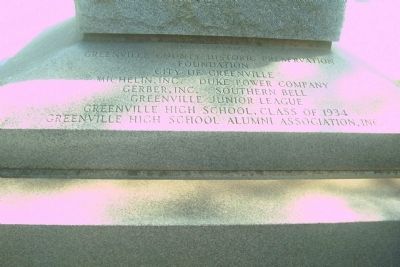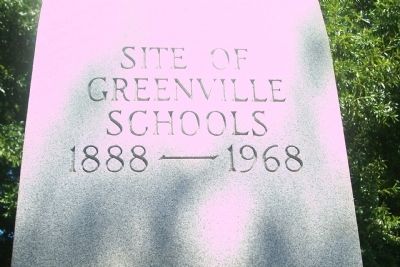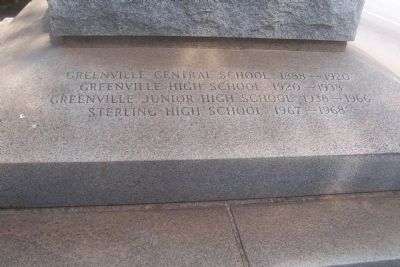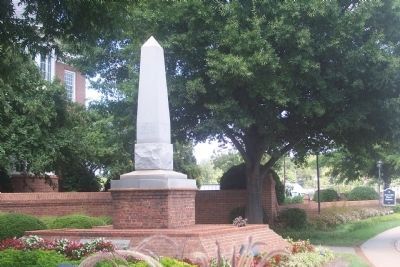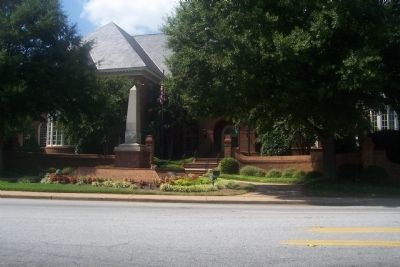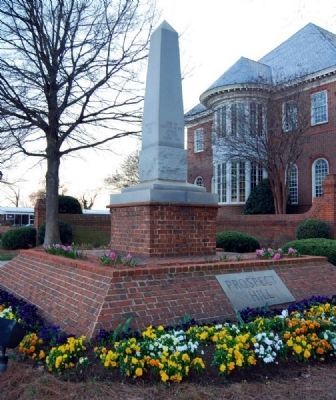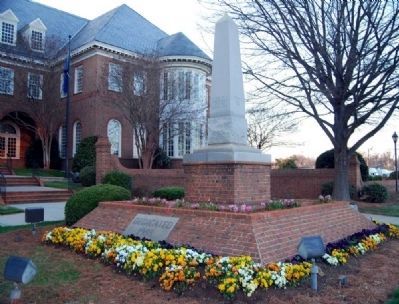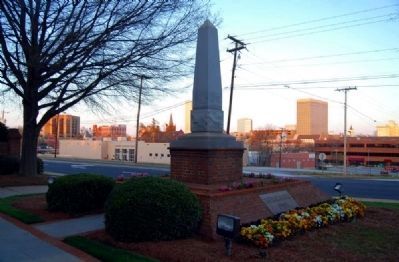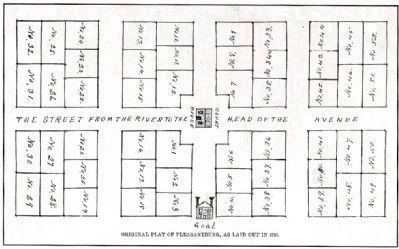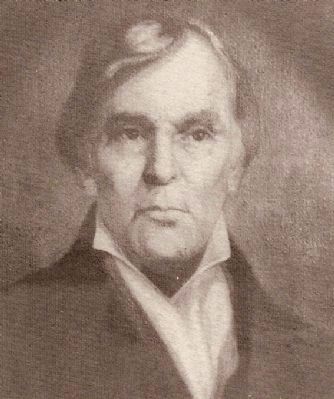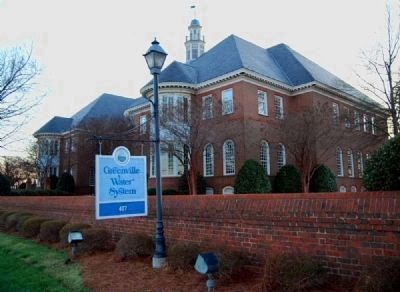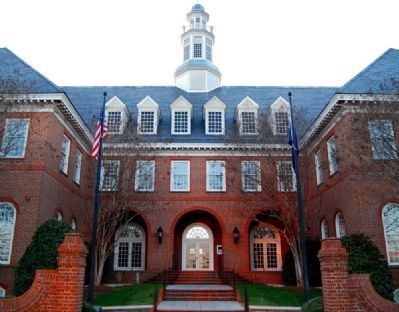Southernside in Greenville in Greenville County, South Carolina — The American South (South Atlantic)
Prospect Hill Park
[East Face - Top Inscription]:
Hill
Park
[East Face - Bottom Inscription]:
Greenville County
Historic Preservation
Commission
[North Face - Top Inscription]:
Alston/McBee
House
Ca. 1799
Razed 1920
[North Face - Bottom Inscription]:
Alston built "Prospect Hill"
Mansion. Sold 1815 to Vardry
McBee, merchant, developer of
Greenville, public benefactor,
who lived here, 1835 - 1864
[West Face - Top Inscription]:
donated by
Greenville High
School
Class of 1935
[West Face - Bottom Inscription]:
Foundation
City of Greenville
Michelin, Inc. Duke Power Company
Gerber, Inc. Southern Bell
Greenville junior League
Greenville High School, class of 1934
[South Face - Top Inscription]:
Greenville
Schools
1888——1968
[South Face - Bottom Inscription]:
Greenville High School 1920 — 1938
Greenville Junior High School 1938 — 1966
Sterling High School 1967 — 1968
Erected by Greenville County Historic Preservation Commission and Greenville High School Class of 1935.
Topics. This historical marker is listed in these topic lists: African Americans • Education • Parks & Recreational Areas. A significant historical year for this entry is 1799.
Location. 34° 51.096′ N, 82° 24.336′ W. Marker is in Greenville, South Carolina, in Greenville County. It is in Southernside. Marker is at the intersection of West Broad Street and West McBee Avenue, on the left when traveling north on West Broad Street. Touch for map. Marker is in this post office area: Greenville SC 29601, United States of America. Touch for directions.
Other nearby markers. At least 10 other markers are within walking distance of this marker. Table Rock Watershed (about 400 feet away, measured in a direct line); Saluda (Poinsett) Watershed (about 400 feet away); Reverence for Water: Feeding the Body, Feeling the Spirit (about 400 feet away); Cherokee in the Upcountry / Beginnings of Greenville Water (about 400 feet away); Lake Keowee Watershed (about 400 feet away); St Mary's Catholic Church (about 700 feet away); Textile Hall (approx. 0.2 miles away); Historic Plants Garden
(approx. 0.2 miles away); Historic River Cane (approx. 0.2 miles away); History of the Reedy River (approx. 0.2 miles away). Touch for a list and map of all markers in Greenville.
Additional commentary.
1. Prospect Hill
The history of Prospect Hill goes back to the late eighteenth century, when the village of Greenville consisted of a few public structures and scattered houses. On the first day of South Carolina's new land grant law of 1784, Colonel Thomas Brandon of Union District, one of many land speculators who surfaced after the Revolution, bought all of the land formerly owned by Greenville's first colonial settler, Richard Pearis. Pearis, a Loyalist, had all his lands confiscated by the new state government. In 1788, Lemuel Alston purchased 11,028 acres (including Thomas Brandon's land) encompassing the entire area of what would become downtown Greenville. He built a two-story wooden mansion on a swell in the land overlooking the city from the west and named it Prospect Hill. Later newspaper accounts record that the clapboard-covered house had two bedrooms on the first floor and four on the second.
Alston's hopes for land sales in Greenville did not meet his expectations (neither did his run for reelection to the South Carolina Congress), so he sold his land and moved to Alabama. Vardry McBee bought all of Alston's land, including his home, for $27,550 in 1815. A.V. Huff writes that in the same year McBee bought Prospect Hill, it was leased to Edmund Waddell, who turned the six-bedroom house into a hotel. It was the villages first documented hotel, a number of which were built in the next decades specifically to house summer residents from Charleston.
When Vardry McBee finally moved to Greenville from Lincolnton [N.C.] in 1836m he returned the Prospect Hill hotel back into a residence that he would live in until his death in 1864. A year after Vardry's death, the property was bought by John Westfield, who is remembered by the street that runs across the hill. (Source: A Guide to Historic Greenville, South Carolina by John M. Nolan (2008), pgs 81-82).
— Submitted April 23, 2010, by Brian Scott of Anderson, South Carolina.
2. Pleasantburg
At the same time that Elias Earle was constructing the wagon road, Lemuel J. Alston was laying out a village around the courthouse at the falls of the Reedy River. In 1797 Alston filed with the clerk of court a plat for the village of Pleasantburg. The
plat consisted of four blocks or squares on each side of Pearis's wagon road between the river and avenue leading to Prospect Hill, Alston's home. Only two streets were named. Present-day Main Street was designated "the Street," and the lane to Prospect Hill, present-day McBee Avenue, was named "the Avenue." In the eight blocks Alston laid off fifty-two lots.
There was no rush to purchase lots, since few Greenville County residents saw the need for building town houses or operating businesses in the village. The first sale of property in what was designated on the deed as "Greenville C.H. Village of Pleasantburg" took place on April 22, 1797, when Isaac Wickliffe purchased lots 11 and 12 on the northwest corner of the courthouse square for one hundred dollars. Over a year later, on September 5, 1798, John McBeth purchased the entire block of six lots on the southwest corner for six hundred dollars. A decade after the lots were first offered for sale, only twenty-six of the fifty-two had been sold. The name Pleasantburg had already dropped out of use -- replaced by Greenville Courthouse, or simply Greenville. (Source: Greenville: The History of the City and County in the South Carolina Piedmont by Archie Vernon Huff (1995), pg 66.)
— Submitted April 23, 2010, by Brian Scott of Anderson, South Carolina.
3. About Vardry McBee
Vardry McBee was perhaps the most pivotal figure in the history of our city and Greenville County as a whole. thanks to his business acumen and impressive foresight for how the community could grow and prosper.
A product of the Carolina frontier, McBee was born in 1775 on the eve of the American Revolution, a conflict that would prove formative in his early years. Both his father and older brother fought with the Patriots, at King's Mountain and the Battle of Cowpens. McBee himself never fought for American independence, but instead used his considerable fortune to improve the lives of his fellow citizens, appropriating his land and fortunes to public projects.
McBee opened the first textile mill on the Reedy River, but he saw value in a diversified economy. In his private business life, that meant he owned two flour mills, a cotton factory, and wool and paper mills. Publicly, even as he approached his 80s, it led him to champion the construction of a railroad line that connected Columbia and Greenville. In 1853, this line became the first rail to serve the community, and it would eventually become a turning point in the economy of the town. (Source: G: The Magazine of Greenville, Jan/Feb 09, pg 66.)
— Submitted April 23, 2010, by Brian Scott of Anderson, South Carolina.
4. More About Vardry McBee
The early history of Greenville had no more interesting or significant figure than Vardry McBee, who in fact measured up to all that was intended when he was called "a model man of enterprise for the South and the country." After he had passed the high tide of life's activities, and twelve years before his death, which occurred at Greenville, January 23, 1864, in his eighty-ninth year, an interesting sketch of his career was published in De Bow's Review of September, 1852. It is a historic document, and the salient features of the article are reproduced here.
He was born in Spartanburg District of South Carolina, June 19, 1775, and the Revolutionary battles of Cowpens and Cedar Springs were fought within a few miles of his father's home, and he was old enough to see and be impressed by many events of that struggle. His parents came from Virginia and were among the earliest settlers of Upper Carolina. His father, though of the religious faith of the Friends, commanded a company for several years in the Revolution. After the war, being heavily in debt, he had to mortgage his property, including the famous Limestone Springs, and finally lost his fortune altogether.
Vardry had to leave school at the age of twelve and for the next six years was a farm laborer on the Limestone Farm, where his father remained, though the title had passed to other owners. In 1794 he began an apprenticeship at the saddler's trade at Lincolnton, North Carolina. During 1800, after completing his apprenticeship he was employed for a brief time as a clerk in Charleston, but in the fall of the same year accompanied his parents on their removal to Kentucky. The following year he established a saddlery in middle Tennessee, but soon returned to North Carolina and engaged in business as a merchant at Lincolnton, where he prospered and laid the foundation of a large fortune. In 1805 he retired from mercantile lines, and devoted his time to agriculture and other increasing interests. Agriculture was his favorite subject, and he reclaimed a large amount of badly worn soil and again and again carried off premiums for maximum productiveness of his fields. Fully three-quarters of a century ago he was practicing the modern doctrine of restoring soil fertility by the use of clovers and other leguminous crops. In 1812 he was elected clerk of the County Court at Lincolnton and held that office twenty-one years.
While Mr. McBee did not become a resident of Greenville until 1836, he had bought in 1815 a large domain of several thousand acres in and around the village. At that time he had only a modest fortune, as fortunes were then estimated, and it was against the protests
of friends and relatives that he bargained with Col. L.J. Allston for these lands at a price of $27,500. While a few acres of the property at the present time would appraise at more than that figure, it required unusual sagacity and foresight to approve the wisdom of the purchase 100 years ago. Greenville then contained only a few houses and about a hundred inhabitants, but Mr. McBee saw it on one of the great western thoroughfares, recognized its climatic and topographic advantages, and particularly the immense water power which would make a great center of industry.
Soon after making the purchase he gave his personal impetus to industrial progress, building a flour mill in the village in 1817, another one of stone in 1829. Seven miles below the city on Reedy River, he developed from time to time a nucleus of manufactures, including grist mill, paper mill, cotton factory, and woolen mill —- all pioneer industries that have special interest to the modern industrial City of Greenville.
After removing to Greenville in 1836 he devoted himself to the improvement of his lands and agriculture. He would have been an exceptional farmer even in the twentieth century, since he abhorred the idea of "mining" the wealth of the soil, and always practiced the sound policy of steadily making his land better.
He was extremely liberal toward every local improvement. He gave lands for tht male and female academy at Greenville and sites for the various churches. In the history of early railroad construction through this part of the South his name and service are indelibly fixed. He succeeded General Hayne as president of the project of the Louisville & Cincinnati Railroad. When the project of the Greenville & Columbia Railroad was about to fail, he subscribed $50,000, thus making the largest individual subscription ever made to a railroad in the United States up to that time. He also liberally supported the enterprises of the Seaboard & Rpanoke and the Charleston, Louisville & Cincinnati Railroads.
To quote the direct words of the article from which the above is taken: "It may with great truth be said of Mr. McBee, that very few men who have made their fortunes have appropriated so much of them to public purposes * * * Mr. McBee never engaged in an enterprise that did not succeed. As a saddler he commenced his fortune, had a high reputation for his work, and laid the foundation of that immense estate which he now owns. As a merchant, with numerous branches of his mercantile business at Lincolnton, Spartanburg, Greenville and elsewhere, during some fifty years, he has been everywhere successful. As an extensive manufacturer of cotton and woolen cloths and paper he has been equally successful.
"In morality and all the proprieties of life, Mr. McBee has no superior. His habits are all strictly temperate and methodical. He is a man of great industry and activity. He retires to bed early and arises before daylight every morning. Having been crippled when a young man, by being thrown from a horse, he is not able to walk any distance. He consequently lives mostly in his saddle during the day. Although now nearly seventy-seven years old, he rides fifty miles a day, and feels no inconvenience from it. He enjoys fine health, though his constitution has always been delicate. There is the same uniformity and regularity in his dress that there is in his habits and manners. In person, Mr. McBee is small, with a mild and pleasing expression of face. In his manners he is kind and gentle, with the simplicity of a child. Seldom is he excited by anything, but there is in him a sleeping passion which is sometimes aroused."
In 1804 he married Miss Jane Alexander, daughter of Col. Elias Alexander of Rutherford County, North Carolina. The unfretted currents of their lives ran side by side for nearly sixty years, and she died less than two months after her beloved husband on March 13, 1864. A granddaughter of this historic couple is Mrs. C.M. Landrum of Greenville, from whom this data was secured. (Source: History of South Carolina, Volume 4 by Yates Snowden, pgs 261-262.)
— Submitted April 23, 2010, by Brian Scott of Anderson, South Carolina.
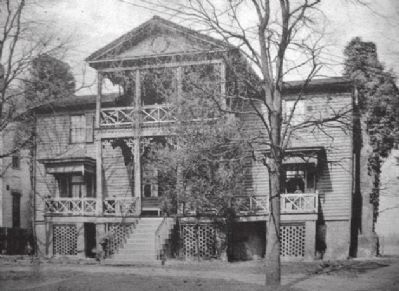
A Guide to Historic Greenville, South Carolina by John M. Nolan
14. Prospect Hill
Prospect Hill is the historic homesite of Lemuel Alston, the man responsible for laying out the first village plat in 1797. The wooden house was built in the late eighteenth century and later served as Vardry McBee's residence.
Credits. This page was last revised on February 16, 2023. It was originally submitted on September 19, 2008, by M. L. 'Mitch' Gambrell of Taylors, South Carolina. This page has been viewed 3,284 times since then and 104 times this year. Photos: 1, 2, 3, 4, 5, 6, 7, 8, 9, 10. submitted on September 19, 2008, by M. L. 'Mitch' Gambrell of Taylors, South Carolina. 11, 12, 13, 14, 15. submitted on April 23, 2010, by Brian Scott of Anderson, South Carolina. 16. submitted on September 20, 2009, by Brian Scott of Anderson, South Carolina. 17, 18. submitted on April 23, 2010, by Brian Scott of Anderson, South Carolina. • Christopher Busta-Peck was the editor who published this page.
